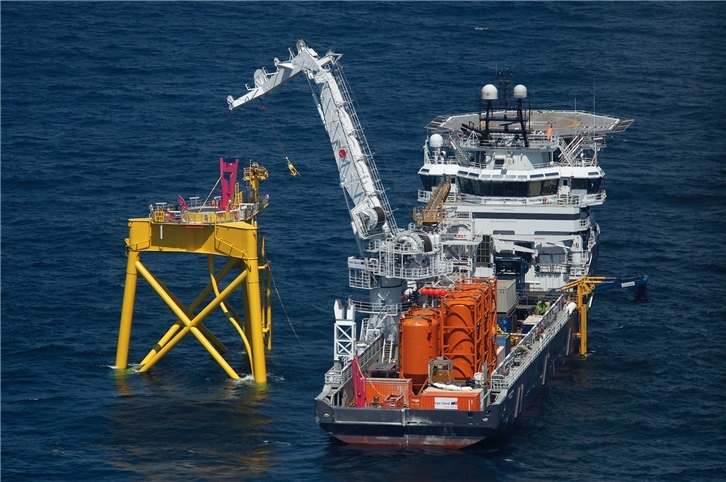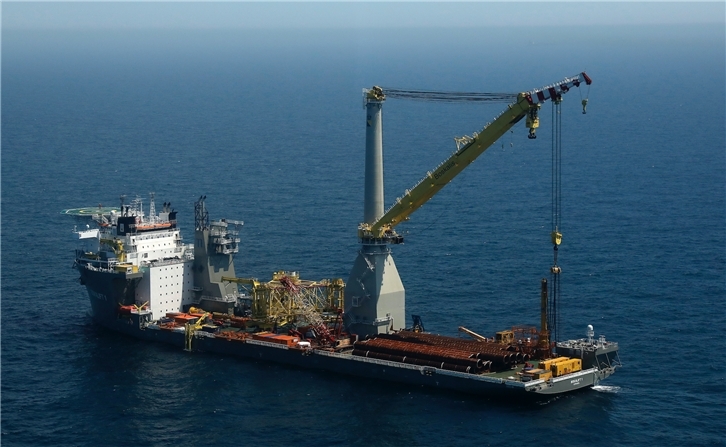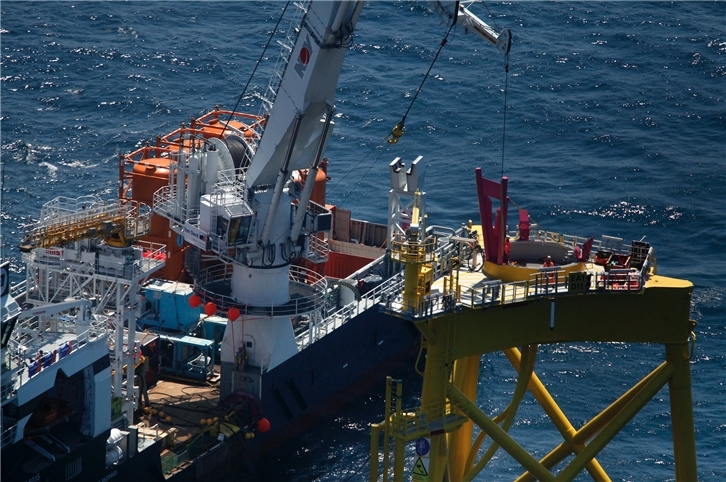News
With an investment of more than £2.5 billion, it is the biggest renewable project so far developed by a Spanish company
Iberdrola advances in the construction of East Anglia One: starts installation of first jackets
- Project acts as prime mover for other Spanish companies: Navantia is constructing 42 jacket foundations, and Windar is preparing 126 piles, in a project that is creating an average of 800 jobs, employing as many as 1,300 people at peak points
- It will come on stream in 2020 and generate enough clean energy to supply more than half a million London households
Iberdrola is moving ahead on its East Anglia One offshore wind farm project off the UK’s Suffolk coast in the southern North Sea, and has started installing the first jacket foundations, constructed by Navantia at its facilities in Fene (Galicia, north-western Spain) and the piles, constructed by Windar at its facilities in Avilés (Asturias, bordering Galicia to the east).
Over the next few months, a total of 42 jacket foundations, each with a total height (i.e. including the underwater part) of 65.5 metres will be installed, together with 126 piles and the other components. When completed, the wind farm will have an installed capacity of 714 megawatts (MW), and with total investment exceeding £2.5 billion it will be the biggest renewable project so far developed by a Spanish company.
East Anglia One will come on stream in 2020 and generate enough clean energy to supply more than half a million London households
Project acts as prime mover for other Spanish companies
The East Anglia One wind farm has become a prime mover for Spanish companies and certain sectors such as shipbuilding: for the second time, following the Wikinger offshore wind farm project (in the German part of the Baltic Sea), Iberdrola has commissioned Navantia and Windar to develop some of the wind turbine components at their facilities in Spain.
Construction of these components is generating one million hours of work, creating an average of 800 jobs and employing as many as 1,300 people at peak points, thus ensuring the continuity of these companies’ businesses in Spain.
Siemens Gamesa will supply the 102 7-MW turbines for the farm from its new facilities in Hull, in the north-east of England.
Unprecedented size in the renewables sector
The size of the project is unprecedented in the Spanish renewables industry:
- the wind farm will occupy an area of more than 300 square kilometres (km2) (116 square miles, equivalent to 30,000 football pitches);
- the cable taking the power from the wind farm to terra firma will be 85 kilometres or 53 miles long (the distance from Madrid to Toledo or London to Cambridge);
- the substation will cover an area of 1,144 m2 (just over four tennis courts equivalent);
- the foundations for the wind turbines will weigh around 747 tons, about the same as two jumbo jets; and
- the wind turbines will have 75-metre blades and a rotor diameter of 154 metres, mounted on jacket foundations with a height of 65.5 metres (of which 40-48 metres underwater) bringing the total height of the wind turbine to 235 metres.
The East Anglia One offshore wind farm forms part of a more ambitious project, since Iberdrola has asked the UK government for permission to expand this offshore facility to 2,000 MW. It has submitted a proposal to the UK authorities to build the East Anglia Three Wind Farm, which will have a capacity of 1,200 MW.
Setting the pace in the drive for offshore wind power
Having invested more than €90 billion in clean energy since 2001, Iberdrola has become a world leader in wind power and has increased its asset base sixfold.
In accordance with its Strategic Prospects for 2018-2022, renewables will continue to be one of the group’s main plays, accounting for 37% of the total of €32 billion in capital expenditure scheduled for the period.
Nearly twenty years after pioneering the move into onshore wind-powered generation, the company has now decided to spearhead the development of the renewable energy source with the best growth prospects: offshore wind. It is going to do this in three main areas: the North Sea, the Baltic Sea and off the Atlantic coast of the USA.
The group currently has two facilites up and running:
- the West of Duddon Sands wind farm, commissioned in 2014 in the Irish Sea, the first such plant to be promoted by a Spanish company;
- and the Wikinger wind farm, in the German sector of the Baltic Sea, which has been operational since December 2017.
In the next few years Iberdrola will build up its stake in offshore wind generation with new projects.
Recently, through Vineyard Wind, the company received authorisation from the Massachusetts Electric Distribution Companies (EDC) to construct a wind farm off the east coast of the United States. The project, which will involve the company’s large-scale deployment in this business in the US, will have installed capacity of 800 MW. These facilities form part of the State of Massachusetts' goals to develop offshore wind infrastructure under its Green Communities Act.
Added to this award is that achieved by Iberdrola in Germany in April, for the construction of two new offshore wind farms in the Baltic Sea, with a total capacity of 486 MW: Baltic Eagle and Wikinger South.
In June, Iberdrola reached agreement with the French government for the development of the Saint-Brieuc offshore wind farm. It will have a capacity of 496 MW and will be located in Bay of Saint-Brieuc, 20 kilometres off the coast of Brittany.
Growth and an essential component in the energy mix
According to the latest report of the International Renewable Energy Agency (IRENA) ‘Innovation Outlook: offshore wind’, offshore wind capacity could grow from 13 GW in 2015 to 400 GW in 2045. Exponential growth, which very few technologies would be capable of achieving. By 2030 the market for offshore wind power is expected to reach 100 GW of installed capacity worldwide.
The report predicts that offshore wind power will become a significant component in the global energy mix during the next thirty years.
According to the report, the introduction of technological advances such as next-generation turbines with bigger rotors, and advances in electricity transmission, will be significant.
The report also foresees turbines being available with a unit power of 10 MW in the 2020s and perhaps 15 MW in the 2030s.








